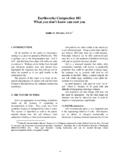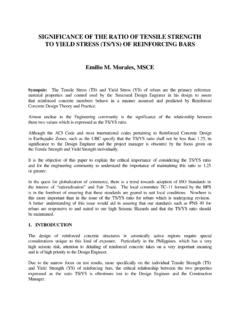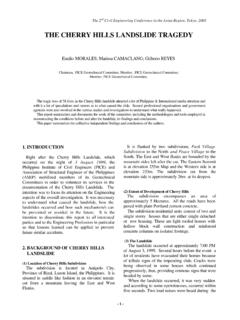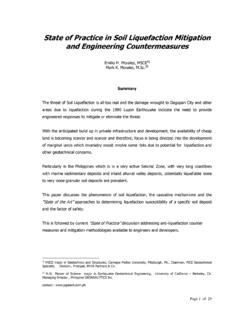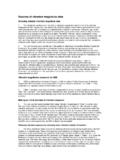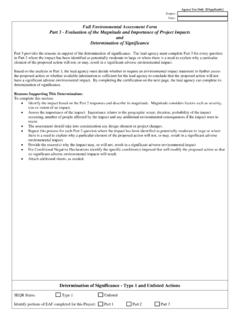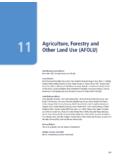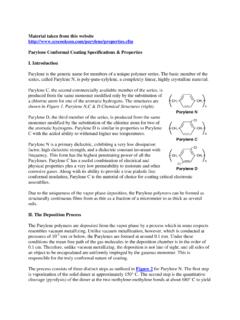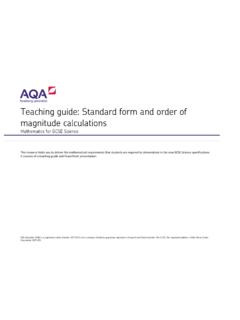Transcription of Calculation of Actual Concrete Shrinkage Magnitude
1 Calculation of Actual Concrete Shrinkage Magnitude By: Emilio M. Morales, MSCE - Master of Science in Civil Engineering major in Geotechnics and Structures, Carnegie Mellon University, Pittsburgh Pa. Chairman PICE Geotechnical Division, Former Senior Lecturer Graduate School, Dept of Civil Engineering, UP Diliman. Mark K. Morales, - Master of Engineering Major in Geoengineering, University of California - Berkeley, CA. Former Member of the faculty, Mapua Institute of Technology CE Department., Member of the Faculty, Graduate School, Dept. of Civil Engineering, UP Diliman. INTRODUCTION Most often, the quantification of Shrinkage strains and Magnitude are not necessary requirements, as provision of adequate number and spacing of Shrinkage and construction joints normally would ensure a trouble free Concrete slab construction.
2 It is only when troubles arise like serious cracking and curling is there a need to look into Actual magnitudes particularly if liability or litigation threats are in the offing. The Actual Magnitude of Shrinkage strains are quantifiable based on well established procedures published by the American Concrete Institute (ACI 209R-92).1] Particularly, this calculations would be needed in order to determine whether a member would crack or not due to Shrinkage or if the problem of cracking is due to some other causes. In such cases, it is necessary that the Actual Magnitude of Shrinkage strains be determined to ensure that these strains do not exceed the permissible limits. Prediction of Actual Shrinkage Values based on ACI 209R-92 Concrete shrinks due to moisture loss.
3 However, the Actual Magnitude of ultimate Shrinkage is dependent on a lot of factors as contained in ACI 209R-92. These factors are: Relative Humidity Minimum Thickness Water Cement Ratio W/C Slump Air Content Fines Content 1] ACI Committee 209. Prediction of Creep, Shrinkage and Temperature Effects in Concrete Structures . ACI 209F-92 contained in ACI Manual of Concrete Practice, 1996, Part 1. In order to predict the Actual Shrinkage , it is necessary to perform Actual calculations taking into account the foregoing factors. Totally neglecting these procedures renders any conclusion invalid and at best highly speculative. The use of a real construction problem would best illustrate the need for and importance of Calculation procedures based on universally accepted State of Practice.
4 This was what happened in a real world project of ours, 2] where major Shrinkage cracking has occurred; blame is being placed squarely on the Engineer of Record with various claims that are unsubstantiated. One of these is a claim by the contractor s hired foreign consultant that Shrinkage stresses even with the high W/C ratio is not the cause of cracking. The consultant even provided oversimplified calculations just to justify that cracks were not due to Shrinkage since by not being able to do so, the very high and non compliant W/C ratio as placed will surely point to the main reason for the cracking. In order to disprove the self serving and highly erroneous calculations presented, we proceeded with the appropriate Calculation based on a rational procedure as recommended in ACI Committee 29 1].
5 This is the main topic of this article and by outlining the procedures taken, the reader/s will be guided in how Actual Shrinkage is calculated which even if complicated is required particularly when the problem blows into a litigation headache. 2] For Obvious Reasons the Project and personages involved cannot be named. Calculation of the Ultimate Shrinkage Value The ultimate Shrinkage value SH can be predicted for conditions other than standard 3] using: ssssssSHSHHDsFBACxKxKxKxKxKxK Where: SH = is the strain at standard or other conditions SH = Ultimate Strain sHK = Correction Factor for Relative Humidity sDK = Correction Factor for Minimum Member Thickness ssK = Correction Factor for Concrete Consistency sFK = Correction Factor for Fine Aggregate Content sBK = Correction Factor for Cement Content sACK = Correction Factor for Air Content The attached charts in Appendix B give the corresponding values used on our calculations for the various conditions based on ACI 209R-92.
6 Based on the foregoing equation and quantification of Actual conditions for the specific project (see Appendix A for a complete detail of the above.) The following values for the correction factors for ambient Project conditions have been used. Factor Actual Condition at Time of Pour A] Shrinkage Correction Factor Ambient Relative Humidity 85% Minimum Thickness 100mm Cement Content 285 Slump 2 inches Air Content 2% Fines Content 50% Product A] Assumed Values applied to both conditions uniformly. 3] The standard conditions are based on US conditions.
7 The foregoing values need to be applied on the Ultimate Shrinkage Value SH to yield the Shrinkage strains at Actual conditions. It is not correct to use assumed Standard Values as was done by the contractor s Foreign Consultant for the Concrete in question because the conditions were not standard for this project. In addition, the Concrete as poured by the contractor excessively violates the specified maximum Water Cement Ratio W/C (Specified vs. Actual ) by based on tests of Water Content and Water Cement Ratio W/C conducted by a New Zealand Laboratory and as cited in the contractor s Consultant Final Report. However, the effect on the resulting strains is non linear and is greater at higher water contents. The Portland Cement Association4] has a widely accepted and well documented procedure for prediction of what Shrinkage strains could be under various Water Cement Ratios and under other equally important considerations for the ambient project conditions existing during the pour.
8 (thus, it is important for the consultant and the PM to record these conditions at every pour). The chart below is taken from Reference and shows how the Shrinkage contribution from various Water Cement Ratios could be quantified: From: Ref. PCA Handbook Design of Concrete Mixtures, 13th Ed. Page 155. 5] 4] Steven H. Kosmatka and William C. Panarese. Design and Control of Concrete Mixtures . Thirteenth Edition. Portland Cement Association, Old Orchard Road, Skokie, Illinois. 5] Kong. Handbook of Structural Concrete . ACI Method 209 Shrinkage Correction Factors. Fig. 2-7- Chapter 11, -age 12, Pitman Publishing, Inc., Mass. 1983. Based on these charts, and with the following Actual data: W/C Ratio As Specified Resulting Water Content is gallons/CY W/C Ratio actually poured Determined from average of Lab test W/C= The resulting Water Content is (Computed from submittal gallons/CY of Mix Design From these values, the Upper Band of the curve is entered to yield the following Shrinkage magnitudes: Shrinkage Value In millionths As specified W/C = 290 As poured and determined By New Zealand Lab W/CAve = 1,020 There is significantly, a lesser Shrinkage value based on the specified W/C of over normal Concrete and a very large increase in the case of excessive W/C as provided (W/C= provided vs.))
9 W/C= specified). The values obtained, 290 microstrain or and microstrain or mm/meter are used as base or reference figure in predicting quantitatively the Actual Shrinkage magnitudes in this specific case using ACI 209 procedures. The effects of various other factors can be introduced further. It can be seen from the above that the Actual Ultimate Shrinkage Strains ( SH ) produced by the as poured Concrete (W/C= ) is greater than for the specified Concrete ( vs. mm/meter). If the Shrinkage correction factors as prescribed by ACI 209 are applied, the resulting Actual Shrinkages would be: SH Product of Shrinkage Correction Factors Ultimate Shrinkage Values Concrete As Specified W/C= mm/meter mm/meter Concrete As Poured W/C= (Contractor) mm/meter mm/meter Prediction of Shrinkage at any Time Based on ACI 209R-92 Shrinkage prediction at any time after age 7 days for moist cured Concrete is given by equation 2-9 ACI 209R-92 as follows: 35 SHSH ttut where.
10 SHt = Shrinkage at any time (t) t = Time in days after the end of initial Wet curing SHu = Ultimate Shrinkage value This equation is a very powerful tool in quantifying the Actual Magnitude of Shrinkage at any time but more importantly during the moist critical stage of strength development when the Concrete has not yet fully attained its design strength. Using the above Equation 2-9 with a curing period of 14 days as specified, the following Shrinkage strain factors are generated for various times beyond the 14 day initial wet curing period. Period Time Days Shrinkage Correction Value 1 0 0 2 5 3 15 4 25 5 35 6 45 7 85 8 105 9 125 10 165 11 205
